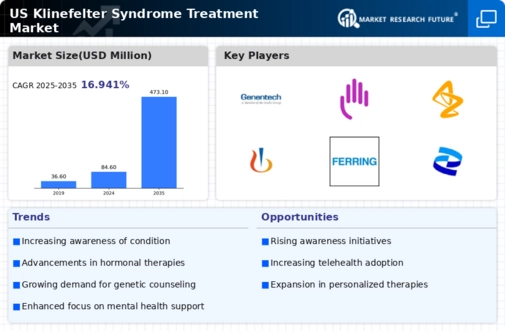The klinefelter syndrome-treatment market is characterized by a competitive landscape that is increasingly shaped by innovation, strategic partnerships, and a focus on patient-centric solutions. Key players such as Pfizer Inc. (US), Merck & Co., Inc. (US), and Novartis AG (CH) are actively engaged in enhancing their product offerings and expanding their market presence. Pfizer Inc. (US) has positioned itself as a leader in the therapeutic area by investing in research and development, particularly in hormonal therapies that address the symptoms of klinefelter syndrome. Meanwhile, Merck & Co., Inc. (US) has adopted a strategy of collaboration with academic institutions to foster innovation in treatment methodologies, thereby enhancing its competitive edge. Novartis AG (CH) appears to be focusing on digital health solutions, integrating technology into treatment protocols to improve patient outcomes, which collectively shapes a dynamic competitive environment.
In terms of business tactics, companies are increasingly localizing manufacturing and optimizing supply chains to enhance efficiency and reduce costs. The market structure is moderately fragmented, with several players vying for market share, yet the influence of major companies remains substantial. This competitive structure allows for a diverse range of treatment options, catering to the varying needs of patients with klinefelter syndrome.
In October 2025, Pfizer Inc. (US) announced a strategic partnership with a leading biotechnology firm to develop a novel gene therapy aimed at addressing the genetic underpinnings of klinefelter syndrome. This collaboration is expected to leverage cutting-edge research and could potentially revolutionize treatment options, positioning Pfizer at the forefront of innovation in this therapeutic area. The strategic importance of this move lies in its potential to not only enhance treatment efficacy but also to establish Pfizer as a pioneer in genetic therapies for rare conditions.
In September 2025, Merck & Co., Inc. (US) launched a new patient support program designed to provide comprehensive care for individuals diagnosed with klinefelter syndrome. This initiative emphasizes the company’s commitment to holistic patient management, which is increasingly recognized as essential in chronic disease treatment. By focusing on patient education and support, Merck aims to improve adherence to treatment regimens, thereby enhancing overall patient outcomes and satisfaction.
In August 2025, Novartis AG (CH) unveiled a digital platform that integrates telehealth services with traditional treatment protocols for klinefelter syndrome. This platform allows for continuous monitoring and personalized treatment adjustments, reflecting a growing trend towards digitalization in healthcare. The strategic significance of this initiative lies in its ability to enhance patient engagement and streamline communication between healthcare providers and patients, potentially leading to better health outcomes.
As of November 2025, the competitive trends in the klinefelter syndrome-treatment market are increasingly defined by digitalization, sustainability, and the integration of artificial intelligence (AI) into treatment protocols. Strategic alliances among key players are shaping the landscape, fostering innovation and enhancing treatment accessibility. Looking ahead, competitive differentiation is likely to evolve from traditional price-based competition to a focus on innovation, technological advancements, and supply chain reliability, underscoring the importance of delivering high-quality, patient-centered care.

















Leave a Comment